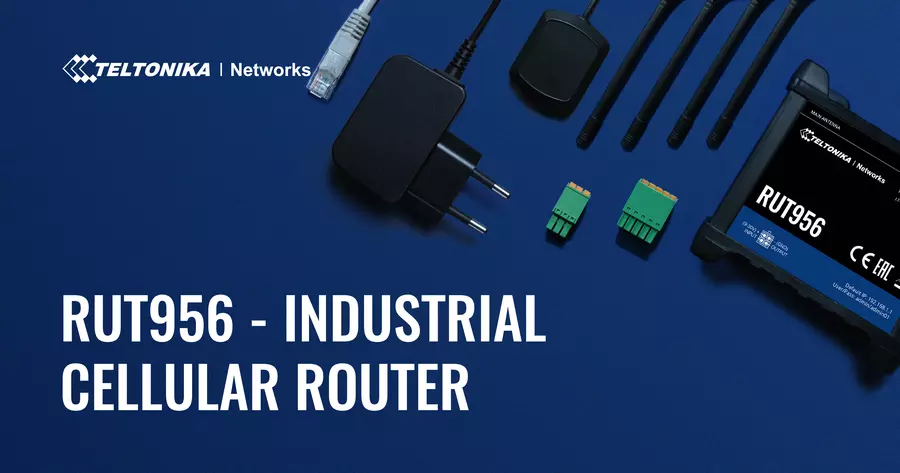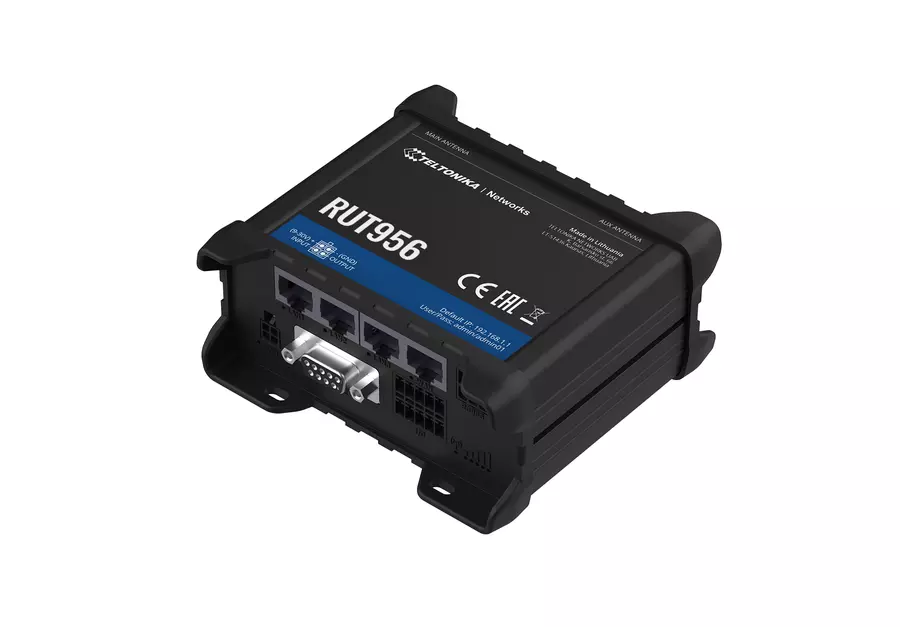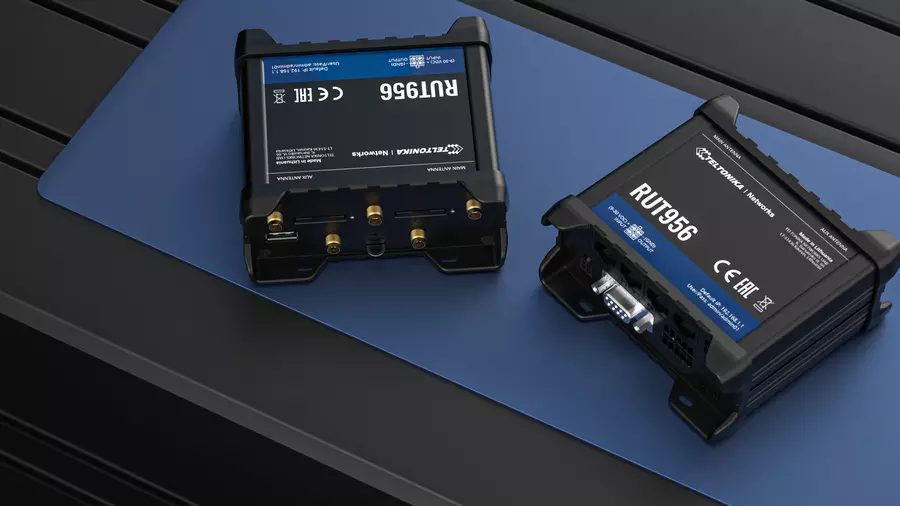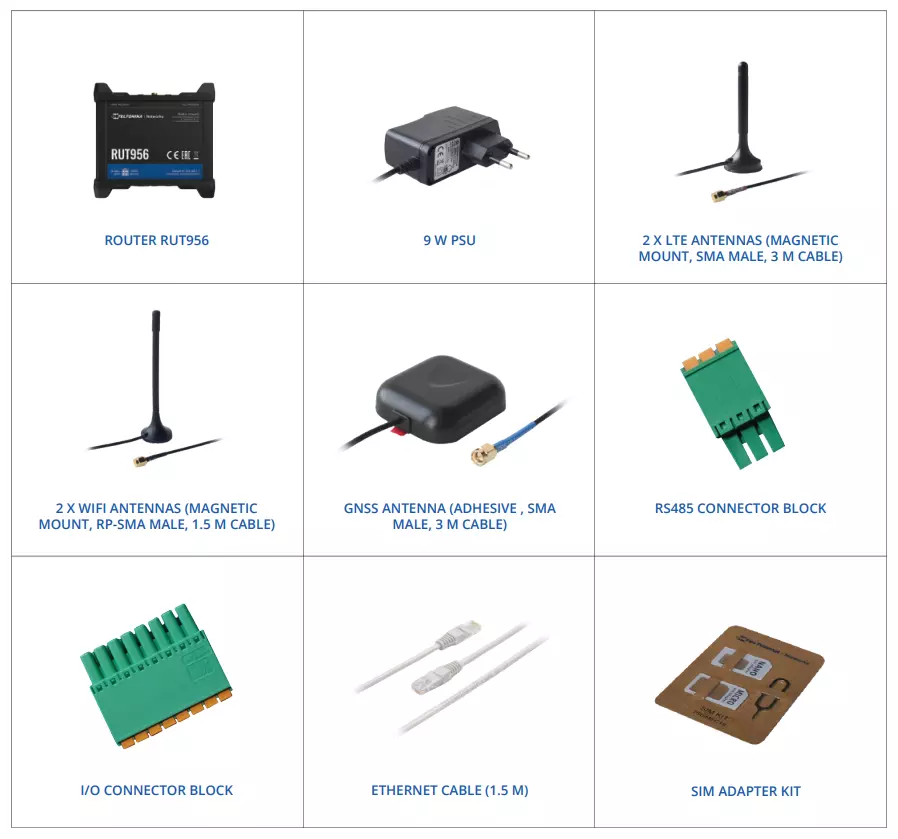TELTONIKA RUT956 LTE ROUTER, DUAL SIM, 4X FE, GNSS RUT956 100000


TheTeltonika RUT956 is an industrial router that combines 4G LTE cellular, Wi-Fi and wired dual-SIM connectivity options and additionally offers GNSS functionality. The device is equipped with 4G dual-SIM cellular connectivity , Wi-Fi and 4 Ethernet interfaces to meet the needs of the most diverse IoT solutions.

Automatic WAN failover ensures that the solution continues to operate even if the primary connection is lost.

Serial communication interfaces allow more devices, even legacy devices, to be integrated into the solution ecosystem. Digital and analog I/O with advanced RutOS software features facilitate equipment control, automation and event notification.

Teltonika RUT956 has advanced industrial software functions including Modbus, SNMP, TR-069, NTRIP, MQTT and multiple VPNs.


| Features / filters | |
| Communication type | 4G/LTE, GPS, Wi-Fi, |
| LTE category | Cat.4 (150Mb/s Download, 50Mb/s Upload) |
| Maximum wireless transmission speed | 300 Mb/s |
| Number of LAN ports | 4x 10/100BaseTX (RJ45) |
| Operating frequency | 2.4 GHz |
| Wireless network standards | IEEE 802.11n |
| Additional connectors / interfaces | RS232, RS485, |
| Antenna gain | Under 10dbi |
| Dual SIM | Yes |
| IP Rating | IP30 |
| LTE bands | B1 (2100MHz), B3 (1800MHz), B5 (850 MHz), B7 (2600MHz), B8 (900MHz), B20 (800MHz), B40 (2300MHz), |
| RAM memory | 128MB |
| Type of device power supply | Passive PoE, Power supply, |
| USB port | 1x USB |
| Variant | RUT956 100000 |
| Mobile network | |
| Mobile module | 4G (LTE) - Cat 4 up to 150 Mbps 3G - up to 42 Mbps 2G - up to 236.8 kbps |
| SIM switch | 2 SIM cards, automatic switching cases: weak signal, data limit, SMS limit, roaming, no network, network access refusal, data connection failure, SIM card inactivity protection |
| Status | Signal Strength (RSSI), SINR, RSRP, RSRQ, EC/IO, RSCP, bytes sent/received |
| SMS | SMS status, SMS configuration, sending/reading SMS via HTTP POST/GET, EMAIL to SMS, SMS to EMAIL, SMS to HTTP, SMS to SMS, scheduled SMS, SMS autoreplay, SMPP |
| Black/white list | Black/white list of operators |
| Bandwidth management | Band lock, display of bandwidth status in use |
| APN | Auto APN |
| Bridge mode | Direct connection (bridge) between mobile ISP and device in LAN |
| Passthrough | The router assigns its mobile WAN IP address to another device on the LAN |
| Multiple PDNs (optional) | Ability to use different PDNs to access multiple networks and services |
| Wireless networks | |
| Wireless mode | IEEE 802.11b/g/n, access point (AP), station (STA) |
| Wi-Fi security | WPA2-Enterprise - PEAP, WPA2-PSK, WEP, WPA-EAP, WPA-PSK; AES-CCMP, TKIP, Auto Cipher, client separation |
| SSID | SSID stealth mode and access control based on MAC address |
| Wi-Fi users | Up to 100 simultaneous connections |
| Hotspot | Captive portal (hotspot), internal/external Radius server, embedded in a configurable landing page |
| Ethernet | |
| WAN | 1x WAN (can be configured for LAN) 10/100 Mbps, IEEE 802.3, IEEE 802.3u compliant, supports Auto MDI/MDIX |
| LAN | 3x LAN port, 10/100 Mbps, compliant with IEEE 802.3, IEEE 802.3u standards, automatic MDI/MDIX support |
| Network | |
| Routing | Static routing, dynamic routing (BGP, OSPF v2, RIP v1/v2, NHRP) |
| Network protocols | TCP, UDP, IPv4, IPv6, ICMP, NTP, DNS, HTTP, HTTPS, FTP, SMTP, SSL v3, TLS, ARP, VRRP, PPP, PPPoE, UPnP, SSH, DHCP, Telnet client, SNMP, MQTT, Wake On Lan (WOL) |
| VoIP passthrough support | H.323 and SIP-alg protocol NAT helpers for proper routing of VoIP packets |
| Call monitoring | Ping Reboot, Wget Reboot, Periodic Reboot, LCP and ICMP for link inspection |
| Firewall | Port forwarding, network traffic rules, custom rules |
| DHCP | Static and dynamic IP allocation, DHCP relayd |
| QoS | Prioritization of traffic by source/destination, service, protocol or port, WMM, 802.11e |
| DDNS | >25 service providers supported, others can be configured manually |
| Network backup | VRRP, mobile, wired, Wi-Fi options, any of which can be used as a backup, using automatic failover |
| Load balancing | Balancing Internet traffic across multiple WAN connections |
| SSHFS (optional) | Possibility of mounting a remote file system via SSH protocol (not available in standard software) |
| Security | |
| Authentication | Shared key, digital certificates, X.509 certificates |
| Firewall | Pre-configured firewall rules can be enabled via Web.UI, Unlimited firewall configuration via CLI, DMZ, NAT, NAT-T |
| Preventing attacks | DDOS prevention (SYN protection, SSH attack prevention, HTTP/HTTPS attack prevention), Port scan prevention (SYN-FIN, SYN-RST, X-mas, NULL flags, FIN scan attacks) |
| VLAN | Tag-based VLAN separation |
| Mobile limit control | Setting custom data limits for the SIM card |
| WEB Filter | Black list to block unwanted websites, white list to determine allowed sites |
| Access control | Flexible access control for TCP, UDP, ICMP packets, MAC address filters |
| Secure Boot | Cryptographic integrity check of each boot process (available with special order code RUT950U072C0) |
| VPN | |
| OpenVPN | Ability to run multiple clients and servers simultaneously, 12 encryption methods |
| OpenVPN encryption | DES-CBC, RC2-CBC, DES-EDE-CBC, DES-EDE3-CBC, DESX-CBC, BF-CBC, RC2-40-CBC, CAST5-CBC, RC2-64-CBC, AES-128-CBC, AES-192-CBC, AES-256-CBC |
| IPsec | IKEv1, IKEv2, supports up to 4 IPsec VPN tunnels (instances), with 5 encryption methods (DES, 3DES, AES128, AES192, AES256) |
| GRE | GRE tunnel |
| PPTP, L2TP | Client/server services can run simultaneously |
| Stunnel | Proxy designed to add TLS encryption functionality to existing clients and servers without changing program code |
| DMVPN | A method for building scalable IPsec VPN networks |
| SSTP | SSTP client instance support |
| ZeroTier | ZeroTier VPN |
| WireGuard | WireGuard VPN client and server support |
| Modbus TCP Slave | |
| ID filtering | Reply to one identifier in the range [1;255] or any |
| Allow remote access | Allow access over WAN |
| Custom Registers | MODBUS TCP Custom Register Block requests that read/write to a file inside the router and can be used to extend the functionality of the MODBUS TCP Slave |
| Modbus TCP Master | |
| Supported functions | 01, 02, 03, 04, 05, 06, 15, 16 |
| Supported data formats | 8 bit: INT, UINT; 16 bit: INT, UINT (MSB or LSB first); 32 bit: float, INT, UINT (ABCD (big-endian), DCBA (little-endian), CDAB, BADC) |
| MODBUS RTU MASTER (RS232) | |
| Supported transmission rates | From 300 to 115200 |
| Supported functions | 01, 02, 03, 04, 05, 06, 15, 16 |
| Number of data bits | 5 to 8 |
| Number of stop bits | 1 or 2 |
| Parity | None, Even, Odd |
| Flow | None, RTS/CTS, Xon/Xoff |
| Duplex | Full duplex |
| Supported transmission rates | From 300 to 115200 |
| MODBUS RTU MASTER (RS485) | |
| Supported functions | 01, 02, 03, 04, 05, 06, 15, 16 |
| Number of data bits | 8 |
| Number of stop bits | 1 |
| Parity | None, Even, Odd |
| Flow | None, Xon/Xoff |
| Duplex | Half duplex |
| Modbus data to server | |
| Protocol | HTTP(S), MQTT, Azure MQTT |
| MQTT Gateway | |
| MQTT Gateway | Enables sending commands to and receiving data from a MODBUS Master via an MQTT broker |
| DNP3 | |
| Supported modes | TCP Master, DNP3 Outstation, RTU Master |
| Monitoring and management | |
| Web.UI | HTTP/HTTTPS, status, configuration, FW update, CLI, troubleshooting, event log, system log, kernel log |
| FOTA | Remote firmware update from server, automatic notifications |
| SSH | SSH (v1, v2) |
| SMS | SMS status, SMS configuration, sending/reading SMS via HTTP POST/GET |
| Call | Restart, Status, WiFi on/off, Mobile data on/off, Output on/off |
| TR-069 | OpenACS, EasyCwmp, ACSLite, tGem, LibreACS, GenieACS, FreeACS, LibCWMP, Friendly tech, AVsystem |
| MQTT | MQTT Broker, MQTT publisher |
| SNMP | SNMP (v1, v2, v3), SNMP trap |
| JSON-RPC | API management over HTTP/HTTPS |
| MODBUS | MODBUS TCP status/control |
| RMS | Teltonika Remote Management System (RMS) - Teltonika Remote Management System |
| IoT platforms | |
| The cloud of things | Allows monitoring of: Device data, Mobile data, Network information, Availability |
| ThingWorx | Allows you to monitor: WAN Type, WAN IP Mobile Operator Name, Cellular signal strength, Cellular network type |
| Cumulocity | Allows you to monitor: Device model, revision and serial number, Mobile Cell ID, ICCID, IMEI, connection type, carrier, signal strength, WAN type and IP |
| Azure IoT Hub | Can send device IP, number of bytes sent/received/ 3G connection status, network link status, IMEI, ICCID, model, manufacturer, serial number, revision, IMSI, Sim status, PIN status, GSM signal, WCDMA RSCP WCDMA EC/IO, LTE RSRP, LTE SINR, LTE RSRQ, CELL ID, operator, operator number, connection type, temperature, Azure IoT Hub server PIN number |
| System parameters | |
| CPU | Mediatek MIPS 24Kc 580 MHz |
| RAM | 128 MB, DDR2 |
| Flash Memory | 16 MB, SPI Flash |
| Software/Configuration | |
| Web.UI | Update software from file, check software on server, configuration profiles, configuration backup, restore point |
| FOTA | Software/configuration update from server |
| RMS | Software/configuration update for multiple devices |
| Save settings | Software update without losing current configuration |
| Operating System | RutOS (OpenWrt operating system based on Linux) |
| Supported languages | Busybox shell, Lua, C |
| Development Tools | SDK with included graphical environment |
| Location tracking | |
| GNSS | GPS, GLONASS, BeiDou, Galileo and QZSS |
| Coordinates | GNSS coordinates via WebUI, SMS, TAVL, RMS |
| NMEA | NMEA 0183 |
| NTRIP | NTRIP (Network Transport of RTCM over Internet Protocol) |
| Server software | Supported Server Software TAVL, RMS |
| Geofencing | Configurable multiple geofence zones |
| SERIAL | |
| RS232 | DB9 connector, full RS232 (with RTS, CTS) |
| RS485 | RS485 Full Duplex (4 wires) and Half Duplex (2 wires). Transmission speed 300-115200 |
| Serial functions | Console, Serial over IP, Modem, MODBUS Gateway, NTRIP Client |
| Inputs/Outputs | |
| Inputs | 1 x voltage free digital input (0 - 3 V), 1 x galvanically isolated digital input (0 - 30 V), 1 x analog input (0 - 24 V), 1 x digital non-isolated input (on 4-pin power connector, 0 - 5 V detected as logic low, 8 - 30 V detected as logic high) |
| Outputs | 1 x open collector digital output (30 V, 250 mA), 1 x SPST relay output (40 V, 4 A), 1 x Open collector digital output (30 V, 300 mA, on 4-pin power connector) |
| Event handling | SMS, EMAIL, RMS |
| USB | |
| Applications | Samba, USB-to-serial sharing |
| External devices | Ability to connect external hard drive, flash memory, additional modem, printer |
| Recording formats | FAT, FAT32, NTFS |
| Data transmission speed | USB 2.0 |
| Power supply | |
| Connector | 4-pin industrial DC power connector |
| Input voltage range | 9 - 30 VDC (4-pole industrial socket), reverse polarity protection, surge protection >33 V DC 10 us max. |
| PoE (passive) | Passive PoE over spare pairs (available from hardware version 0007 and batch number 0010) Power over LAN port, incompatible with IEEE802.3af, 802.3at and 802.3bt |
| Power consumption | < 2 W in idle mode, < 7 W max. |
| Physical interfaces (ports, LED, antennas, buttons, SIM) | |
| Ethernet | 4x RJ-45, 10/100 Mbps |
| I/O | 2 x inputs and 2 x outputs on 10-pin industrial socket, 1 x digital input and 1 x digital output on 4-pin power connector (available from firmware version 1600 and higher) |
| LEDs | 1 bi-color connection status LED 5 connection strength LEDs 4 LAN status LEDs 1 power LED |
| SIM | 2 x SIM Slots (Mini SIM - 2FF), 1.8 V/3 V External SIM tray eSIM (optional) |
| Power supply | 4-pin industrial DC power connector |
| Antennas | 2x SMA for LTE, 2x RP-SMA for Wi-Fi antenna, 1 x SMA for GNSS |
| Reset | Buttons for restarting/restoring factory settings |
| RS485 | 1 x 6-pin industrial socket |
| RS232 | 1 x DB9 socket |
| USB | 1 x USB A port for connecting external devices |
| Inputs/Outputs | 1x 10-pin industrial socket for I/O |
| Physical characteristics | |
| Housing material | Aluminium housing, plastic panels |
| Dimensions | 110 x 50 x 100 mm |
| Weight | 287g |
| Mounting options | DIN rail (can be mounted on two sides), placement on flat surface |
| Work environment | |
| Ambient temperature range during operation | From -40°C to 75°C |
| Ambient humidity during operation | 10% to 90%, non-condensing |
| Protection class | IP30 |
| Certificates | |
| Regulations | CE/RED, UKCA, CB |
| EMI Immunity | |
| Standards | EN 301 489-1 V2.2.3, EN 301 489-17 V3.2.4, Final draft EN 301 489-52 V1.2.0, EN 55032:2015 A1:2020, EN 55035:2017 A11:2020, EN 61000-3-3:2013 A1:2019, EN IEC 61000-3-2:2019 |
| ESD | EN 61000-4-2:2009 |
| Radiation resistance | EN 61000-4-3:2020 |
| EFT | EN 61000-4-4:2012 |
| Surge immunity (AC power port) | EN 61000-4-5:2014 A1:2017 |
| Resistance to conduction | EN 61000-4-6:2014 |
| DIP | EN IEC 61000-4-11:2020 |
| RF | |
| Standards | EN 300 328 V2.2.2, EN 301 908-1 V13.1.1, EN 301 908-2 V13.1.1, EN 301 908-13 V13.1.1 |
| Security | |
| Standards | EN IEC 62311:2020 AS/NZS 60950.1:2015 IEC 62368-1:2018, EN IEC 62368-1:2020 A11:2020 |
The difference between the RUT956 100000 and RUT956 200000 is the different LTE/3G frequency bands.
